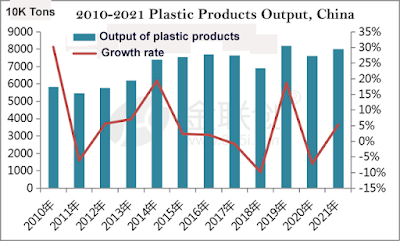According to statistics from the U.S. Environmental Protection Agency, the U.S. produced 35.4 million tons of plastic in 2017. If people want to reduce plastic pollution, recycling may be an easy solution. But when you dump these plastic containers into the recycling bin, what will happen and how much plastic is recycled?

However, waste recycling does not always give new life to plastic waste. On the contrary, human beings are gradually being overwhelmed by plastic...
How much plastic is recycled?
Unfortunately, the end result of plastic recycling is not as simple as many people imagine. John Hocevar, a marine biologist at Greenpeace in the United States, said that recycling is unlikely to give plastic products new life. In fact, only 8.4% of plastic waste is eventually recycled. It is not because consumers do not take the initiative to recycle or they have not initiated recycling measures, but because the United States does not have the infrastructure to match plastic recycling.
Hocevar said: "In most parts of the United States, many plastic wastes are not recyclable." Recently, a Greenpeace report investigated 367 plastic waste recycling facilities in the United States and found that only plastic bottles are regularly recycled. For disposal, many plastic packages are usually landfilled or incinerated.
Recycling Numbers
It should be noted that not all plastic products are the same plastic. If you look at the bottom of transparent plastic bottles (for example: plastic bottles for food and washing powder), you will notice that there is a number in a triangular recycling symbol. If it is "1", it means that plastic product is made of a material called polyethylene terephthalate (PET); some opaque plastic bottles (for example: plastic bottles for milk), the triangle symbol number is "2", which means it is made of high-density polyethylene (HDPE). In the garbage recycling treatment plant, plastic waste is classified according to these numbers (a total of 7 numerical levels), which indicate the degree of recyclability of the plastic.
Kara Pochiro, director of the American Plastics Recycling Institute, said that relatively speaking, plastic items of recycling number 1 and # 2 can be recycled. These plastic wastes are shredded, melted into balls, and then sold to manufacturers for reprocessing. Recycled plastic can be used to make carpets, clothes, plastic packaging and other products.
How about plastics above the recycling number 2?
He also pointed out that the recycling and processing of plastic products with higher digital levels is more complicated. According to statistics from Greenpeace, this type of plastic waste accounts for 69% of our daily use of plastics. Disposing of them is more complex than processing plastic products No. 1 and No. 2. It requires higher costs and consumes more energy. In the past few years, many garbage collection agencies in the United States sold mixed plastic waste to Asian countries, but two years ago, these countries banned the import of foreign plastic waste.
For this reason, garbage collection agencies have to adopt new garbage disposal channels, but most attempts have failed. For example, the Los Angeles Garbage Disposal Center still does not process plastic garbage above #2. In 2019, the Guardian reported that some garbage collection agencies are dumping garbage into landfills or incinerators.
Pochiro pointed out that what the United States currently needs is to have the infrastructure to process other types of plastics. But Hocevar envisions a different solution: the really simple answer is that we must stop manufacturing so many single-use plastic products. In other words, does plastic recycling make sense? For No. 1 or No. 2 plastic bottles, the answer is "yes", but more and more plastic products labeled #5, which is a kind of flexible plastic, including yogurt boxes, are increasingly being recycled. For plastic products of other recycling numbers, it is important to check the restrictions and regulations of the local recycling system.
Hocevar's answer is simpler: for plastic products 3, 4, and 5, their recycling costs are higher, and the benefits of recycling outweigh the disadvantages.




No comments:
Post a Comment